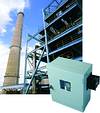

Rosemount Analytical offers a wide selection of CEMS solutions, to fit the requirements specific to the user's industry. From compact, field-mountable systems to custom-designed CEMS that will keep the plant in compliance and assist in fine-tune the process.
For applications having limited equipment space available
The MicroCEM Continuous Emissions Monitoring System is suitable for any industry requiring a complete CEM system that fits a small space, or one that can be directly mounted at the process.
This complete continuous emissions monitoring system is housed in two compact, field-mountable enclosures. The MicroCEM extracts a sample gas, conditions the sample, analyses the sample for specific constituents and processes the emissions data via the required calibration validation calculations/procedures. The unit serves as a data acquisition system, storing relevant raw/diluent corrected emissions, flags, calibrations and alarms for three months. Data can be accessed over distances, using the MicroCEM pocket PC handheld. The pocket PC allows the user to easily scroll through menus and view data via the high-resolution display. Alternatively data can be accessed from a desktop computer via specialised software. (Picture shows MicroCEM).
Modular solutions
Rosemount's modular continuous emissions monitoring systems feature the NGA 2000 MLT2 Multi-Component Gas Analyser, the SCP 100 Sample Conditioning Package and the SP 110 Sample Extraction Probe. These components are designed for field installation. The reduced size of this type of CEMS system minimises the cost of installation compared to the traditional, high-cost shelter approach. This shelterless system is suitable for mounting directly in the field under an inexpensive, three-sided protective covering. It is also available in an explosion-proof wall mount, temperature controlled housing. The sample-conditioning portion of the system is housed in a compact, purgeable weatherproof enclosure.
The NGA 2000 MLT2 measures up to five gas components in a single or dual compartment, IP65 wall-mount enclosure. For CEMS applications, the MLT2 is configured as a 'system control analyser' with front panel display and keypad and for hazardous areas, the MLT2 can also be equipped with an impact tested, intrinsically safe front panel.
Rosemount's SCP 100 sample-conditioning package combines moisture removal, sample and calibration valving, flow regulation and power distribution in a compact, wall-mount enclosure. Integral temperature control circuits regulate the sample line and probe temperatures. A thermoelectric cooler controls the condensation of entrained moisture vapour to present a dry sample for analysis, and the sample is moved to the sample handling systems by a diaphragm vacuum pump. Once the sample is dry, sample pressure and flow is regulated for delivery to the analyser. Daily calibration and other routine tasks are performed automatically by the analyser. All system functionality can be manually initiated for troubleshooting and testing. The analyser eliminates the need to the integration of a separate PLC or external control system.
The Model SP 110 sample extraction probe has standard features for supporting automatic probe blowback, including an accumulator tank and dual blowback air ports for purging both the sample filter and the sample pick-up tube.
Applications would include:
* Gas turbines - Rosemount CEMS are suitable for the low emissions requirements of gas turbines.
* CO-generation facilities - Depending on the geographic location, type of fuel burned and plant size, any or all of the following parameters may be monitored: CO, O2, CO2, SO2, NOX, THC, NH3 and opacity.
* Refining - Process heaters and FCC units often require enhanced sample handling features.
* Utilities and municipalities - With emissions allowances being a potentially valuable commodity, accurate and reliable CEMS are a necessity.
* Industrial boilers - Depending upon the size and location of the plant, CEMS may be required.
* Commercial and institutional boilers - Typical measurements include CO, CO2, SO2, NOX, O2 and opacity.
* Pulp and paper - Pulp and paper facilities may be required to measure CO, O2, SO2, NOX and opacity in a variety of emissions sources including power and recovery boilers.
* Cement kilns - Rosemount Analytical offers cost-effective, pre-engineered systems for cement kiln applications.
* Selective catalytic reduction (SCR) Systems - A NOX measurement is used upstream of the SCR to control the federate and downstream of the SCR for NOX emissions compliance.
For more information: Johan van der Spuy, Alpret Control Specialists, 011 249 6700, alpret.conspec@frco.com, www.alpret.co.za
| Tel: | +27 11 249 6700 |
| Email: | rfq@acs-autocon.com |
| www: | www.acs-autocon.com |
| Articles: | More information and articles about Automation Control Solutions |
© Technews Publishing (Pty) Ltd | All Rights Reserved